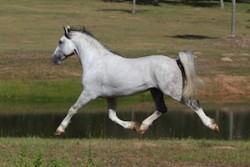 Joint mobility proves a continual concern to any horse owner that is riding, competing and enjoying their equine regularly. It can also be an area of
Joint mobility proves a continual concern to any horse owner that is riding, competing and enjoying their equine regularly. It can also be an area of
trepidation for those owners of older equines. Joint mobility can vary dependent on the age, the breed and the workload of the horse but whether you are a happy hacker or serious competitor it is essential to take good care of your equine’s joints to prevent future problems from occurring.
Correct care of the equine joints will help to minimise the unavoidable daily wear and tear on the joints, limiting the risk of potential problems and allowing your horse or pony to remain mobile, fit and able to perform at their best.
Understanding the joint
A joint describes the point where two or more bones meet and is composed of a number of different parts that all work together allowing the horse to move, bend, stretch, twist and turn within certain limits. Where the two bones meet, the ends of the bone are covered in lubricated cartilage, which absorbs the forces placed upon the joint and limits any friction from occurring.
The equine joint is put under considerable strain in order to bear the weight of the body, assist in movement and also act as a shock absorber. Add a rider’s weight to the equation and you can understand why we need to offer support.
Why do joint problems occur?
Like everything within the body of human and equine alike, problems occur when damage happens faster than the body can repair it. There are many contributing factors which can make joint problems more likely to occur. Age is obviously a factor and healing mechanisms deteriorate as the years go by, poor conformation can cause impact to be absorbed asymmetrically and last but not least, general wear and tear. Other contributing factors can include diet, hoof condition, working excessively on hard or rough round and the equine’s fitness level and muscular tone.
How do you know if your horse has a joint problem?
If you suspect your horse is suffering from joint related pain or discomfort then the first thing to do is seek veterinary advice to ensure there is nothing underlying causing the problem. As part of your daily equine care routine, it is important to keep an eye on your horse’s movement and flexibility in order to identify any abnormalities quickly and efficiently. Signs of issues with the joints may include lameness, heat, swelling, pain and lack of mobility and flexion.
How can you manage joint problems?
There are many ways to manage a horse with mobility issues. Here are a few of our top tips…
- When exercising any horse, particularly if they are suffering from a joint related condition, make sure you include sufficient and effective warm up and cool down sessions as this will help keep joints supple and reduce the chance of damage or friction occurring.
- Remember to bear in mind if you are competing, working at speed or riding your horse over rough terrain, more stress will be placed on your equine’s joints so try to limit this strenuous activity where possible.
- Keeping your horse or pony supple by including stretching exercises into their routine can help keep your horse mobile and comfortable. Click here to see how Mini Horslyx can be used to perform stretching exercises.
Nutritional support
Including a joint supplement into the diet can make a significant difference to those equines at risk of, or suffering from, a joint problem. When considering a joint supplement the key inclusion is Glucosamine; which helps joint mobility by keeping joints and cartilage lubricated, alongside other ingredients such as MSM, which works in synchrony with glucosamine to help contribute to the overall joint health, and Omega Oils which help support and maintain the immune system. These key ingredients can all be found in Mobility Horslyx, which when used regularly can help to support and maintain healthy, supple joints. Mobility Horslyx has been proven by independent university research to increase stride length in horses which were clinically sound but considered stiff when ridden or exercised, click here to read our research study.
